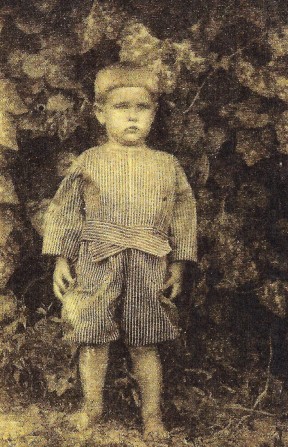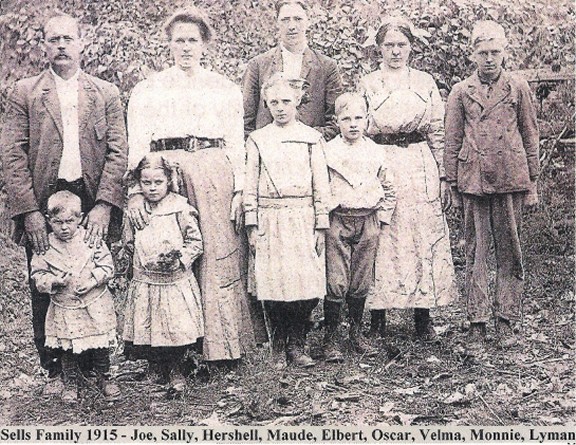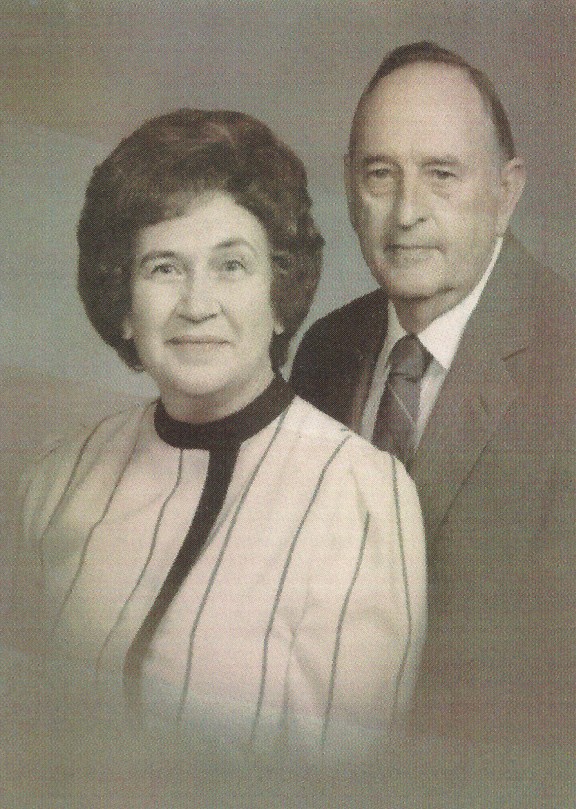|
My Story - By Arnold H. Sells
|
|
Arnold Sells, born in 1919, is shown here at age 3.
|
|
The following was taken by a book written by Arnold
Hughes Sells who grew up in the Independence community of Overton
County, Tennessee, in the early 1920's. Arnold is the son of Joseph
Handy Sells and wife Sarah Elizabeth Hensley. His grandparents on his
father’s side of the family were David Leander Sells and wife Sarah
Amanda Stover. The book Arnold Sells has written is entitled, "My Story
... Memories of My Journey Through Life." A copy has been presented to
the Millard Oakley Public Library and can be found in the Genealogy
Room. Here is just a portion of what Mr. Sells has written about his
life:
"I came into this world on August 25, 1919. I was delivered by Kate Winningham, a local midwife. Doctors were seldom called unless birth complications were anticipated. I was born in the family home in the 7th civil district of Overton County, where my four older brothers and three sisters were born and raised. At the time of my birth, my siblings ranged from 23 years of age to 8 years of age. My mother was 39 and my father was 45. My oldest brother, Hershell, had just returned from France at the conclusion of World War I. My oldest sister, Maude, was already married and had a baby girl named Delma. I was an uncle long before I knew the meaning of the word. "My birth certificate does not record the hour I was born. My father, years later, told me my mother prepared a peach cobbler for dinner on the day I was born. In those days, dinner was served as the mid-day meal and supper as the evening meal. My father invited a friend, Yancy Spicer, who had brought some work for father to do, to stay for dinner. After seeing the advanced stage of my mother’s pregnancy, Yancy said, "Joe, if I had known that Sallie was this far along, I would not have accepted your invitation." The peach cobbler became a Sells family tradition for my birthday every year. "Sometime prior to my third birthday, my father purchased a general merchandise store and house located in on a small tract of land in the center of the Independence community. The store, along with an elementary school and several surrounding farmhouses, comprised the core of the community. The property was located on the main road, about midway between Livingston and Willow Grove. A small secondary road crossed the main road exactly in front of the store. The residence was located on the west side of the road and the store on the east side. The Independence school was located on the southwest side of the secondary road within a few hundred yards of the store and house. "Sometime around 1921, my father moved the family into a new location. He did not sell the family home and property where the eight Sells children were born until around 1925. He sold the house and the store to Bennie Chat Clark who operated the store many years. Father purchased a house and 25 acres of land about 1/4 a mile south of the store. The house was several years old and had been modified and renovated several times. Originally it must have been a 1 or 2 room log cabin. An open hearth wood-burning fireplace with a stone chimney was used for heating the house. When the family moved in, the house contained four rooms. The main entrance room was used as a combination living and bedroom. Kerosene lamps were used to provide light after darkness. The second room was used as a bedroom. It contained two double beds and two five-drawer dressers. The kitchen contained a pie-safe, a cupboard for storing dishes and a large wood burning cook stove with a baking oven and food warmers on top. "A reservoir for heating water was on the side. The fourth room was used as a dining room. It contained a large wooden table covered with an oil cloth. On one side of the table was a large wooden bench the children used when seated at the table. Usually five or six cane-bottom straight back chairs were available for use as needed around the table. A door from the dining room provided exit to a small stoop and the backyard. "About 50 feet from the back of the house was a hand dug well, walled or lined with stones from which water was obtained for family use. The water table in this area was near the surface of the earth. A bucket tied on the end of a rope would be lowered by hand into the well. When the bucket filled with water, it was pulled by hand to the surface and emptied into the "drinking" bucket. Everyone drank from the same dipper. Further from the rear of the house was a hen house. Nesting boxes were installed in one end of the house to allow for a convenient place for the hens to lay their eggs. Occasionally a hen would hide her nest and stay in seclusion until she brought forth her brood of little chicks. Still further to the rear was a barn that housed the farm animals. "The outside ‘privy’ was located down a path along side of the garden about 300 yards from the house. The Sears Roebuck catalog sure was better than the red and white corn cobs we had to use in the barn. "The Independence community where I grew up was centered around the school and the general store. The majority of the people in Independence were farmers. The terrain surrounding that area ranged from flat land to rolling hills to low, rocky mountains. Farmers grew corn, small grain such as wheat, rye and oats in quantities sufficient to meet the needs of their families. Mules and horses were used for cultivating the crops. Almost every family household raised chickens and one to four hogs, mostly for home consumption. Most families planted a vegetable garden in addition to the main farm crops and many had fruit orchards as well. Apples, peaches, pears, plums, and grapes could all be found in most home orchards. The farm families made a special attempt to be as self-sufficient as possible. Some farmers on larger farms specialized in raising cattle. Some raised beef cattle, others raised dairy cattle for milk and butter products.
|
|
Joseph Handy Sells and wife Sarah Elizabeth Hensley Sells, along with their children, were photographed in 1915.
|
| "Reaching the age of six, I started
to school at Independence. A typical school day started when the teacher
rang the school bell at 8:00 a.m. Weather permitting, the boys and girls
lined up in separate lines in front of the main entrances and upon command
of the teacher, marched into the school house and took their assigned
seats. The next two hours were spent in study or class recitation followed
by a recess of about 30 minutes. During good weather we played softball or
basketball. Dinner (lunch) period lasted for about an hour. Most students
carried their lunch from home. The variety of food depended largely on
what the family had to eat at home. In the winter time the lunch pail
might include a baked sweet potato or a biscuit and sausage or fried egg.
In the summer time lunch varied from fruit in season to corn on the cob
called "rossion ears." I was fortunate to live within walking distance of
the school. I would run home for lunch and run back to school to have more
time to spend on the playground. During the 7th and 8th
grade, basketball became a very popular sport in the county schools.
"In the summertime we played marbles, a favorite game of the younger children. In the fall of the year, we would go hunting for walnuts, hickory nuts, and hazel nuts. It was a real treat to find a vine of wild grapes referred to as "possum grapes." The grapes were small in size and very sweet, especially after the first frost. I shudder today when I think of the chances we took when we used a grape vine to swing over the mountain side, sometimes as much as thirty feet in the air. A slip of the hand or a broken vine would have resulted in a broken arm or leg at the very least. "I remember the first airplane I ever saw on the ground. The pilot of a small single engine plane made an emergency landing in a neighbor’s cow pasture near Oakley, Tennessee. It was in the wintertime and there was a deep snow on the ground. Soon the field was filled with people from the neighborhood. I was there with my father. The plane had come to a stop heading into a small ravine. The men turned the plane around by hand, and with ropes, pulled it to level ground. The snow was so deep the pilot could not get up enough speed to get the plane airborne. My father suggested the men walk six abreast back and forth in the same path to firm the snow on the ground. I remember participating in this effort. The pilot was determined to be on his way, warmed the engine and with the plane headed down the trodden path, made an attempt to take off. The first effort failed, however the second try, the plane lifted off the ground, gained altitude, circled the area, and vanished into the sunlight." The portions I have shared here are only a small sample of the life story of Arnold Sells. The book he has written also includes his obtaining a college education, time spent in the military where he received a serious injury while in service overseas, his marriage to Ruth Moody, niece of the late Raymond Moody of Livingston, along with stories about their family life and his working career. Research in reference to family genealogy is also included in the book. Arnold Sells can be reached at his address of: 7127 Lanier Street, Annadell, Virginia 22003-5810. For a copy of his book ($20.00), send an email request to Christina Stewardson, a granddaughter of Arnold and Ruth Sells. Her email address is: chrisnlee@hotmail.com.
|
|
Arnold H. Sells, who grew up in the Independence community, and his wife Ruth (Moody) Sells, make their home in Annadell, Virginia.
|


